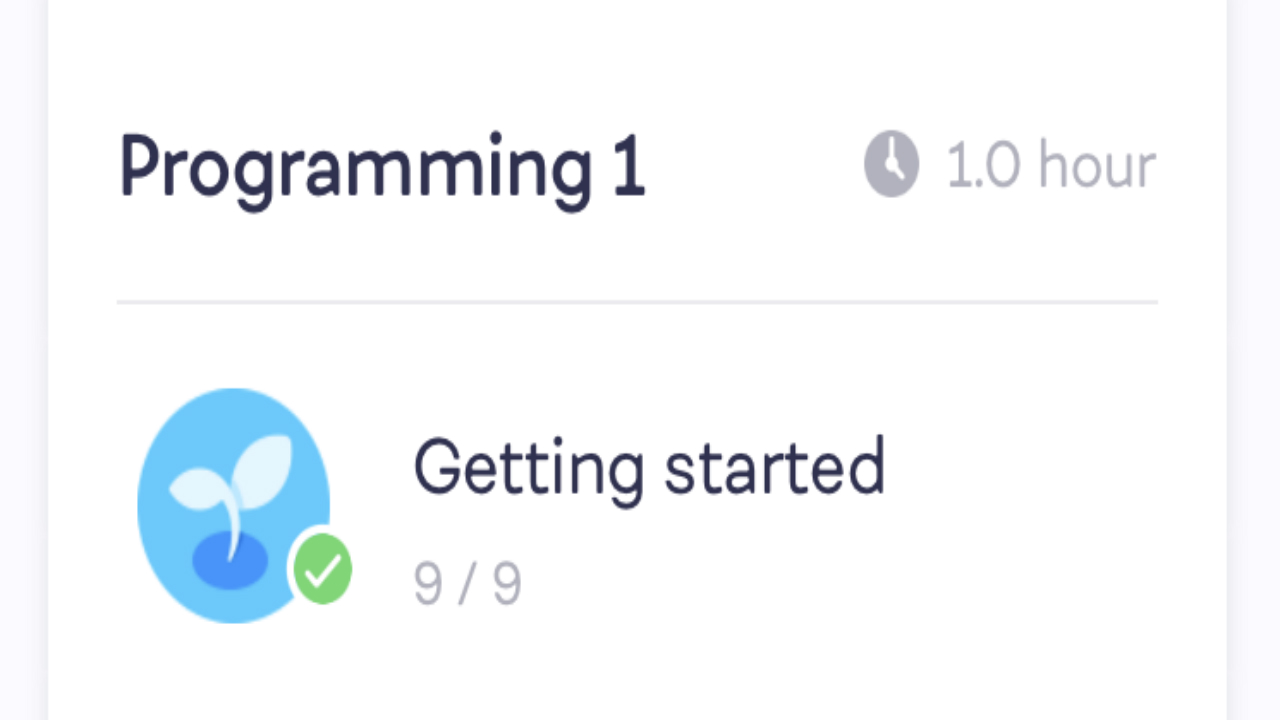google12aaaf8dfdc120e7.html
Top News
Breaking
Recent Post Recent Post
View More google12aaaf8dfdc120e7.html

You can do a ton of things with coding skills, from creating a website to getting an iOS game up and running. As the need for technology continues to grow, more people are considering jobs that involve coding but don’t know where to start. We can help! Check out our top three apps to learn coding.
Top 3 apps to learn coding
Mimo is a great app if you have no coding history. It starts by asking you what your coding experience is and what your goal is for learning to code. Goals include becoming a hacker, making a game, programming and more. After you choose a goal, Mimo takes you through different coding language categories step-by-step, relating coding languages to everyday tasks like making a PB&J sandwich. To unlock everything, you can pay $29.99 for three months of access or $49.99 for a year. Available on iOS and Android.

Encode gives you the options to learn Python, Javascript, and how to make webpages with HTML and CSS. Even though it doesn't break down steps quite as much as Mimo, instructions are still easy to understand. A cool thing about Encode is that it offers an offline download function so you have access to your lessons without an internet connection. Most of the lessons are free, but for some, you'll need Encode Plus where you can purchase them individually for $4.99. Available on iOS and Android.

Udacity teaches a wide array of courses in computer science with coding included. If you search 'programming,' it will take you to courses in coding languages that you can download. Udacity is taught by real people, so some lessons aren't free or available immediately; on the lesson page you'll find the date that the classroom will open and be available for purchase. For example, the classroom for an iOS developer nanodegree opened on September 25 for $999. The only thing this app doesn't have are exercises to practice what you've learned. We would recommend Udacity for more advanced learners of coding. Available on iOS and Android.

Best of luck with your coding career!
The instability created in Europe by the First World War (1914-18) set the stage for another international conflict–World War II–which broke out two decades later and would prove even more devastating. Rising to power in an economically and politically unstable Germany, Adolf Hitler and his National Socialist (Nazi Party) rearmed the nation and signed strategic treaties with Italy and Japan to further his ambitions of world domination. Hitler’s invasion of Poland in September 1939 drove Great Britain and France to declare war on Germany, and World War II had begun. Over the next six years, the conflict would take more lives and destroy more land and property around the globe than any previous war. Among the estimated 45-60 million people killed were 6 million Jews murdered in Nazi concentration camps as part of Hitler’s diabolical “Final Solution,” now known as the Holocaust.
Leading up to World War II
The devastation of the Great War (as WW2 was known at the time) had greatly destabilized Europe, and in many respects World War II grew out of issues left unresolved by that earlier conflict. In particular, political and economic instability in Germany, and lingering resentment over the harsh terms imposed by the Versailles Treaty, fueled the rise to power of Adolt hilter and his National Socialist (Nazi) Party. After becoming Reich Chancellor in 1933, Hitler swiftly consolidated power, anointing himself Führer (supreme leader) in 1934. Obsessed with the idea of the superiority of the “pure” German race, which he called “Aryan,” Hitler believed that war was the only way to gain the necessary “Lebensraum,” or living space, for that race to expand. In the mid-1930s, he began the rearmament of Germany, secretly and in violation of the Versailles Treaty. After signing alliances with Italy and Japan against the Soviet union, Hitler sent troops to occupy Austria in 1938 and the following year annexed Czechoslovakia. Hitler’s open aggression went unchecked, as the United States and Soviet Union were concentrated on internal politics at the time, and neither France nor Britain (the two other nations most devastated by the Great War) were eager for confrontation.
Outbreak of World War II (1939)
In late Au II.
On September 17, Soviet troops invaded Poland from the east. Under attack from both sides, Poland fell quickly, and by early 1940 Germany and the Soviet Union had divided control over the nation, according to a secret protocol appended to the Nonaggression Pact. Stalin’s forces then moved to occupy the Baltic States (Estonia, Latvia and Lithuania) and defeated a resistant Finland in the Russo-Finish War. During the six months following the invasion of Poland, the lack of action on the part of Germany and the Allies in the west led to talk in the news media of a “phony war.” At sea, however, the British and German navies faced off in heated battle, and lethal German U-boat submarines struck at merchant shipping bound for Britain, sinking more than 100 vessels in the first four months of World War II.
World War II in the West (1940-41)
On April 9, 1940, Germany simultaneously invaded Norway and occupied Denmark, and the war began in earnest. On May 10, German forces swept through Belgium and the Netherlands in what became known as “blitzkrieg,” or lightning war. Three days later, Hitler’s troops crossed the Meuse River and struck French forces at Sedan, located at the northern end of the Maginot Line, an elaborate chain of fortifications constructed after World War I and considered an impenetrable defensive barrier. In fact, the Germans broke through the line with their tanks and planes and continued to the rear, rendering it useless. The British Expeditionary Force (BEF) was evacuated by sea from dunkirt in late May, while in the south French forces mounted a doomed resistance. With France on the verge of collapse, betieo musseoo of Italy put his Pact of Steel with Hitler into action, and Italy declared war against France and Britain on June 10.
On June 14, German forces entered Paris; a new government formed by Marshal Philippe Petain (France’s hero of World War I) requested an armistice two nights later. France was subsequently divided into two zones, one under German military occupation and the other under Petain’s government, installed at Vichy. Hitler now turned his attention to Britain, which had the defensive advantage of being separated from the Continent by the English Channel.
To pave the way for an amphibious invasion (dubbed Operation Sea Lion), German planes bombed Britain extensively throughout the summer of 1940, including night raids on London and other industrial centers that caused heavy civilian casualties and damage. The Royal Air Force (RAF) eventually defeated the Luftwaffe (German Air Force) in the battle of britain, and Hitler postponed his plans to invade. With Britain’s defensive resources pushed to the limit, Prime Minister Winston Churchill began receiving crucial aid from the U.S. under the Lend-lease Act, passed by Congress in early 1941.
Operation Barbarossa (1941-42)
By early 1941, Hungary, Romania and Bulgaria had joined the Axis, and German troops overran Yugoslavia and Greece that April. Hitler’s conquest of the Balkans was a precursor for his real objective: an invasion of the Soviet Union, whose vast territory would give the German master race the “Lebensraum” it needed. The other half of Hitler’s strategy was the extermination of the Jews from throughout German-occupied Europe. Plans for the “Final Solution” were introduced around the time of the Soviet offensive, and over the next three years more than 4 million Jews would perish in the death camps established in occupied Poland.
On June 22, 1941, Hitler ordered the invasion of the Soviet Union, codenamed operation BARBAROSSA. Though Soviet tanks and aircraft greatly outnumbered the Germans’, their air technology was largely obsolete, and the impact of the surprise invasion helped Germans get within 200 miles of Moscow by mid-July. Arguments between Hitler and his commanders delayed the next German advance until October, when it was stalled by a Soviet counteroffensive and the onset of harsh winter weather.
World War II in the Pacific (1941-43)
With Britain facing Germany in Europe, the United States was the only nation capable of combating Japanese aggression, which by late 1941 included an expansion of its ongoing war with China and the seizure of European colonial holdings in the Far East. On December 7, 1941, 360 Japanese aircraft attacked the major U.S. naval base at pearl Harbor in hawai, taking the Americans completely by surprise and claiming the lives of more than 2,300 troops. The attack on Pearl Harbor served to unify American public opinion in favor of entering World War II, and on December 8 Congress declared war on Japan with only one dissenting vote. Germany and the other Axis Powers promptly declared war on the United States.
After a long string of Japanese victories, the U.S. Pacific Fleet won the battle of midway in June 1942, which proved to be a turning point in the war. On Guadalcanal, one of the southern Solomon Islands, the Allies also had success against Japanese forces in a series of battles from August 1942 to February 1943, helping turn the tide further in the Pacific. In mid-1943, Allied naval forces began an aggressive counterattack against Japan, involving a series of amphibious assaults on key Japanese-held islands in the Pacific. This “island-hopping” strategy proved successful, and Allied forces moved closer to their ultimate goal of invading the Japanese homeland.
Toward Allied Victory in World War II (1943-45)
In North Africa, British and American forces had defeated the Italians and Germans by 1943. An Allied invasion of Sicily and Italy followed, and Mussolini’s government fell in July 1943, though Allied fighting against the Germans in Italy would continue until 1945.
On World War II’s Eastern Front, a Soviet counteroffensive launched in November 1942 ended the bloody battle of stallingrad, which had seen some of the fiercest combat of the war. The approach of winter, along with dwindling food and medical supplies, spelled the end for German troops there, and the last of them surrendered on January 31, 1943.
On June 6, 1944–celebrated as “D-Day”–the Allied began a massive invasion of Europe, landing 156,000 British, Canadian and American soldiers on the beaches of Normandy, France. In response, Hitler poured all the remaining strength of his army into Western Europe, ensuring Germany’s defeat in the east. Soviet troops soon advanced into Poland, Czechoslovakia, Hungary and Romania, while Hitler gathered his forces to drive the Americans and British back from Germany in the Battle of the Bulge (December 1944-January 1945), the last major German offensive of the war.
An intensive aerial bombardment in February 1945 preceded the Allied land invasion of Germany, and by the time Germany formally surrendered on May 8, Soviet forces had occupied much of the country. Hitler was already dead, having committed suicide on April 30 in his Berlin bunker.
World War II Ends (1945)
At the Potsdam Conference of July-August 1945, U.S. President Harry S. Truman (who had taken office after Roosevelt’s death in April), Churchill and Stalin discussed the ongoing war with Japan as well as the peace settlement with Germany. Post-war Germany would be divided into four occupation zones, to be controlled by the Soviet Union, Britain, the United States and France. On the divisive matter of Eastern Europe’s future, Churchill and Truman acquiesced to Stalin, as they needed Soviet cooperation in the war against Japan.
Heavy casualties sustained in the campaigns at Iwo Jima (February 1945) and Okinawa (April-June 1945), and fears of the even costlier land invasion of Japan led Truman to authorize the use of a new and devastating weapon–the atomic bomb–on the Japanese cities of Hiroshima and Nagasaki in early August. On August 10, the Japanese government issued a statement declaring they would accept the terms of the Potsdam Declaration, and on September 2, U.S. General Douglas MacArthur accepted Japan’s formal surrender aboard the USS Missouri in Tokyo Bay.
World War II proved to be the most devastating international conflict in history, taking the lives of some 35 to 60 million people, including 6 million Jews who died at the hands of the Nazis. Millions more were injured, and still more lost their homes and property. The legacy of the war would include the spread of communism from the Soviet Union into eastern Europe as well as its eventual triumph in China, and the global shift in power from Europe to two rival superpowers–the United States and the Soviet Union–that would soon face off against each other in the Cold War.
Access hundreds of hours of historical video, commercial free, with HISTORY Vault. Start your free trial today.
PHOTO GALLERIES
Subscribe to:
Comments (Atom)


















